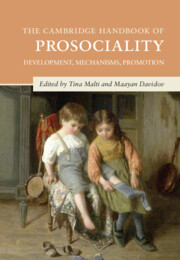Book contents
- The Cambridge Handbook of Prosociality
- Cambridge Handbooks in Psychology
- The Cambridge Handbook of Prosociality
- Copyright page
- Dedication
- Contents
- Figures
- Contributors
- Part I Development of Prosociality
- 1 Introduction: What Is Prosocial Development?
- 2 Developmental Theories of Prosociality
- 3 The Role of Genetics in the Development of Prosocial Behavior
- 4 Neurobiology of Prosociality
- 5 The Developmental Psychophysiology of Prosociality
- 6 The Origins of Prosociality from a Developmental and Comparative Perspective
- 7 Prosocial Behavior in Infancy and Early Childhood
- 8 Prosociality in Middle Childhood
- 9 Prosocial Behaviors in Adolescence
- 10 Prosocial Development across the Lifespan
- Part II Antecedents and Mechanisms of Prosociality
- Part III Development of Prosociality in Context
- Part IV Applications
- Index
- References
9 - Prosocial Behaviors in Adolescence
from Part I - Development of Prosociality
Published online by Cambridge University Press: 25 May 2023
- The Cambridge Handbook of Prosociality
- Cambridge Handbooks in Psychology
- The Cambridge Handbook of Prosociality
- Copyright page
- Dedication
- Contents
- Figures
- Contributors
- Part I Development of Prosociality
- 1 Introduction: What Is Prosocial Development?
- 2 Developmental Theories of Prosociality
- 3 The Role of Genetics in the Development of Prosocial Behavior
- 4 Neurobiology of Prosociality
- 5 The Developmental Psychophysiology of Prosociality
- 6 The Origins of Prosociality from a Developmental and Comparative Perspective
- 7 Prosocial Behavior in Infancy and Early Childhood
- 8 Prosociality in Middle Childhood
- 9 Prosocial Behaviors in Adolescence
- 10 Prosocial Development across the Lifespan
- Part II Antecedents and Mechanisms of Prosociality
- Part III Development of Prosociality in Context
- Part IV Applications
- Index
- References
Summary
This chapter provides an integrative review of the literature on prosocial development across adolescence. Despite core developmental theories addressing biological, cognitive, moral, social, and cultural related domains, our understanding of prosocial development across adolescence in non-Western countries is still quite limited. This chapter summarizes prosocial development work in culturally diverse samples that has application to migrant and minoritized adolescents who navigate a myriad of stressors while pursing work in other countries around the world and when socially integrating into majority communities. These examples highlight the need to deepen the current literature of prosocial development and shed light into more inclusive models of development and on culturally diverse adolescents
- Type
- Chapter
- Information
- The Cambridge Handbook of ProsocialityDevelopment, Mechanisms, Promotion, pp. 163 - 188Publisher: Cambridge University PressPrint publication year: 2023
References
- 1
- Cited by



